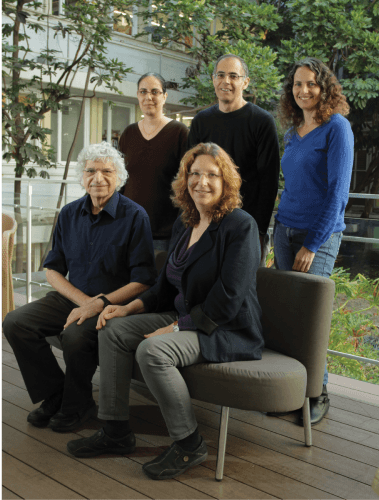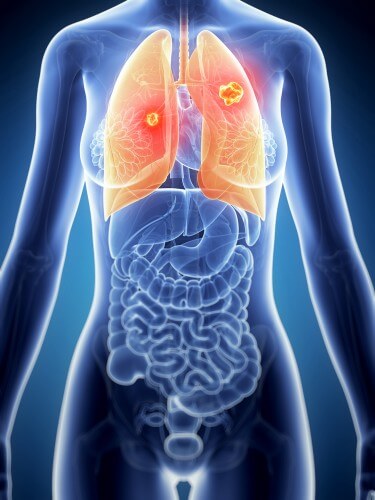Researchers at the Weizmann Institute are developing a test to assess the risk of having this type of cancer that may prevent many deaths. A recent study at the Weizmann Institute of Science offers a combined test, based on three markers, according to which a "DNA repair score" can be determined for each person, which reveals a person's chances of developing lung cancer.

About 85% of smokers will not get lung cancer, but a small percentage of people who do not smoke will fall victim to the serious disease. Smoking is, of course, still one of the main risk factors, but developing a test to assess the risk of having this type of cancer may prevent many deaths. A recent study at the Weizmann Institute of Science offers a combined test, based on three markers, according to which a "DNA repair score" can be determined for each person, which reveals a person's chances of developing lung cancer.
Prof. Zvi Livna and Dr. Tamar Paz-Elitzur, from the Department of Biological Chemistry, have been researching such markers for several years - biological molecules whose increased or decreased activity indicates a risk of cancer. Their research focuses on the cellular DNA repair mechanisms, whose role is to repair damage to the genome, caused, among other things, due to the exposure to the toxic substances found in cigarette smoke. The assumption is that a slight decrease in the function of those repair mechanisms is enough to start the cancer process. Indeed, the scientists discovered such a marker, an enzyme called OGG1, whose activity is closely related to lung cancer: low levels of the enzyme's activity increase five times the risk of contracting the disease.
Although the OGG1 test alone may provide a good indication of risk, Prof. Livna and his team continued to search for additional DNA repair mechanisms, hoping to improve the test and reduce the chances of error. About a year ago they discovered another enzyme, MPG, which is also related to the risk of developing lung cancer. Surprisingly, high levels of MPG activity, rather than low levels, were found to be associated with increased risk. The scientists believe that the balance between OGG1 MPG and other repair enzymes is essential, and that the violation of the balance leads to ineffective repair of DNA damage.
In the current study, which was recently published in the scientific journal Cancer Prevention Research, in addition to Prof. Livna and Dr. Paz-Elitzur, Dr. Ziv Seville, Dr. Yael Leitner-Dagan and Dalia Ellinger from Prof. Livna's laboratory took part, and it was done In collaboration with Prof. Gad Rennert, Dr. Mila Pinchev and Hedi Rennert from the Technion School of Medicine and the Carmel Medical Center, Dr. Ran Kramer from the Rambam Medical Center, Prof. Lawrence Friedman from the Gartner Institute for Epidemiology and Health Policy Research in Tel Hashomer, and Prof. Edna Shechtman from Ben Gurion University of the Negev. The scientists discovered that a third DNA repair enzyme, called APE1, is also associated with lung cancer risk. A high risk was found to be associated with low APE1 activity, despite the fact that high levels of the enzyme are found in mature tumors. The scientists believe that APE1 plays two roles in the different stages of development of the cancer tumor: in healthy cells it operates at a low level, thus allowing the accumulation of mutations that may accelerate the cancerous transformation; In cells that have already become cancerous, on the other hand, increased activity of APE1 is an advantage, because it enables rapid DNA duplication and acceleration of cell division.

The scientists developed a method for weighing the activity levels of the three enzymes to obtain a "DNA repair score", which, together with smoking habits, makes it possible to determine the overall risk. This test (called OMA - acronym for the names of the three enzymes tested) was conducted in 100 lung cancer patients, compared to healthy people, and the test revealed that people who receive a low score in the DNA repair test have a 20-10 times greater risk of developing lung cancer . Although large-scale clinical trials are required to determine the effectiveness of the new test, Prof. Livna is optimistic about its chances of becoming an effective tool for assessing cancer risk, and hopes that it will help identify people who should be sent for early diagnosis, in order to increase the chance of saving their lives. He also plans to develop ways to improve the activity of the damaged repair enzymes, which may lead to the development of a drug that will reduce the risk of lung cancer and other types of cancer.

3 תגובות
Asaf
15% of smokers will get lung cancer. Does this really sound like a joke to you?
And where did you get the nonsense that most smokers will start smoking? Because this is complete nonsense.
And there is no such thing as an "absolute majority". A majority is a majority...
Also 15% and the late Avi Nahum Blizovsky is one of them, that's more than enough. Others die of heart disease (for example my aunt and her husband who had a stroke) were all heavy smokers and barely reached the age of 60.
85% of smokers will not get lung cancer? Sounds like a joke, it is known that the absolute majority get sick as a result of smoking...or you made a mistake in the text..